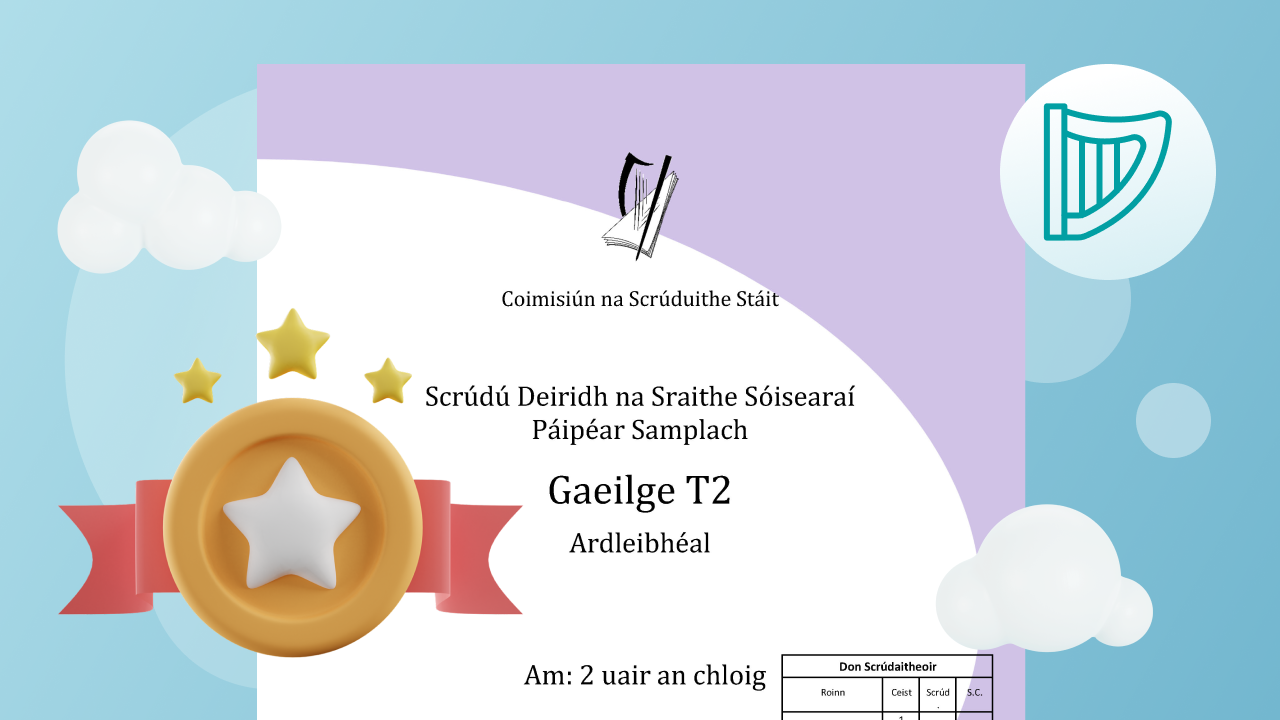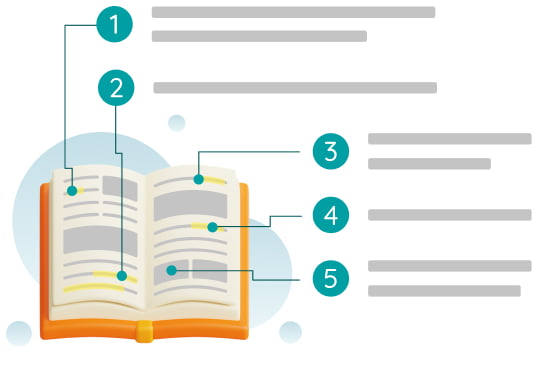The new Junior Cycle Irish course is specifically designed to test students of all levels. To get a distinction, you must achieve at least 270 marks out of 300. The exam is split into two parts: Roinn A (the listening section) and Roinn B (the reading, composition and literature section). The course also includes two Classroom-Based Assessments (CBAs) and an Assessment Task. This guide is designed to take you step-by-step through the Junior Cycle exam, giving you tips and tricks relevant to each question along the way.
How to get a Distinction in Junior Cycle Irish
 By Student Contributor - 8 minute read
By Student Contributor - 8 minute readÁine was a top student in her Irish class and in this guide, she shares some advice that she believes will help you achieve a distinction in Junior Cycle Irish.

Jump to:
Introduction

Classroom-Based Assessments
The CBAs do not count towards the final grade that appears on your Junior Cycle, however, they are still graded and the result will appear on what is known as the Junior Cycle Profile of Achievement (JCPA). Based on the quality of each of your CBAs, you will be awarded one of the following descriptors:
- Exceptional
- Above expectations
- In line with expectations
- Yet to meet expectations
There are two CBAs that must be completed:
CBA 1: the collection of texts
At the beginning of 3rd year, you will begin to prepare your collection of texts. This is a small portfolio of some of your best work from 2nd and 3rd year. You will submit three pieces in total: one must be an audio recording, another must be based on one of the literary texts you have studied (novel, poem or drama) and the last you can choose yourself.
CBA 2: oral presentation
Your CBA 2 will be an oral presentation. This is very similar to the English presentation you will have completed at the end of 2nd year so you will be familiar with the format. You will be asked to give a short presentation in Irish on any topic that interests you. This can be a drama, a speech, an interview, a role play or any other format you want (as long as you have your teacher’s permission). The presentation should last around three minutes and at the end, your teacher will ask you some questions about your presentation. This CBA is nothing to worry about, just make sure you know your content and speak as clearly as possible.

The Assessment Task
The Assessment Task is where all the work you do for your CBAs finally pays off. It is a short test worth 30 marks (10% of your final grade) which you will do during class time after you have completed your two CBAs. The main purpose of the task is for you to reflect on your CBAs; both the things you excelled at and the mistakes you made. You will be asked to answer questions relating to your experience with the CBAs, for example, you may be asked to talk about what you would change if you were to do the CBAs again.
This task should be quite easy as you are being assessed on your own work. Be confident in writing about your experience with the CBAs and you'll do great.

Final assessment breakdown
Roinn A (éisteacht)
The listening portion of the exam is worth 30 marks and it is divided into 4 questions. You will hear each section twice.
To prepare for the listening section, you can test yourself using past exam questions and sample questions, watch the news or other TV shows on TG4 and listen to Irish-language podcasts online.

Roinn B (léamh, ceapadóireacht agus litríocht)
This section is worth 240 marks and is where the majority of your marks will be coming from. There are 7 questions in this section (see below for an overview).

Léamh (question 5)
The reading section consists of a comprehension (léamhtuiscint) and is worth 60 marks. While the questions will be mostly based on the information in the supplied paragraph, the last question will ask for your opinion so it is a good idea to prepare phrases such as:
I mo thuairim... ⇒ in my opinion...
Dar liom/leis/léi… ⇒ according to me/her/him...
Thaitin____liom mar… ⇒ I like____because...
Ceapaim go bhfuil… ⇒ I think that...
Ba mhaith liom… ⇒ I would like...
Mholfainn… ⇒ I would advise...
To prepare for the reading section you can:
- practice answering past papers and sample papers;
- highlight any words you don’t recognise and look them up;
- read Irish as much as possible. It is very important for you to understand the syntax (the way a sentence is formed) of the language in order to understand the paragraph.

Litríocht (questions 6, 8 and 10)
The literature section consists of three questions: one on your studied novel, another on your studied poem and finally, one on either your short story or drama. These questions add up to 110 marks altogether.
The novel question
The novel question is worth 50 marks or around 17% of your total score. The questions will usually be based on the central characters, the relationships between characters, the themes, the setting or the climax of the novel.
The poetry question
The poetry question is worth 30 marks (10% of the total grade). The questions here differ slightly from the novel question but it will still be necessary to learn the themes, emotions and images described in the poem.
The short story/drama question
The short story/drama question is also worth 30 marks in total (10% of the total grade). The question on the short story will be based on the themes, emotions, characters and relationships between characters. For the drama question, you may be asked about the climax of the drama, the characters in the drama or the relationship between two characters. You should also prepare small descriptions of the start, middle and end of the drama as they may ask you to give a summary of a certain part. This question is not guaranteed, unlike the poetry and novel questions, which means there are fewer sample questions to work with. However, you can always ask your teacher for sample questions or just make up your own.
Approaching these questions
I find the best approach to take when writing a response to these questions is to follow the PQE (point, quote, explain) method. This is where you make your point, back it up with some textual evidence or a quote and then explain how that quote proves your initial statement. You should also prepare some ideas for your own opinions of the texts (what you enjoyed, what you liked and what you disliked) as you may be asked for your own input. This method is foolproof and will make ensure you stay on task.
Understand the texts in Irish
Make sure you understand all your texts and can describe them in Irish (even if you have to read through them 4-5 times).
One of the most effective ways to study for any literature question is to look at past papers/sample questions and prepare answers. You will find that you can use some variation of your prepared answers to answer the questions on the exam.

Grammar (question 7)
The grammar question on the paper is worth 10 marks and asks you to correct 10 grammatical errors within a small paragraph. This question can be hard to get full marks in as you must have a very good grasp of Irish grammar in order to recognise the mistakes. A mistake could be as simple as a missing capital letter or a fada or they could be far more complex. Below are some of the concepts that are worth studying to do well in this section:
Verb tenses
Verb tenses like the Aimsir Chaite, Aimsir Láithreach and Aimsir Fháistineach. If you want to be very thorough in your study you can also research the other verb tenses like an Modh Coinníollach (the conditional), an Modh Ordaitheach (the imperative) and an Modh Foshuiteach (the subjunctive).
An Aidiacht Shealbhach
These are the possessive pronouns such as mo, do, a, ár, bhur, etc.
Pluralisation
Pluralisation follows a certain set of rules depending on what declension the word is in. Don’t worry if this sounds too complex as you may already know the plural of a word without understanding the rule, e.g. 'cáilín' to 'cáilíní'.
An Tuiseal Ginideach
This is the possessive case. This is usually found where two nouns are beside each other, in which case the second noun is changed. For example, 'mála' and 'scoil' become 'mála scoile'.
Aidiachtaí Chomparáideach
These are comparative adjectives such as déanach, níos déanaí and is déanaí.
Réamhfhocail
These are prepositions such as liom, leat, leis, etc.
Although there is only one formal grammar question, it is still important to study grammar as it will help you a lot in the composition questions.

Composition (questions 9 and 11)
The composing questions can differ from year to year and can include any piece of composition such as blogs, speeches, emails, letters, advertisements, essays, magazine articles, etc. The composition questions add up to 60 marks overall (20% of the total grade). It is recommended that you fill all the space you are given for these questions as if you leave too much space blank you may be penalised. To prepare for these questions you can:
Write and memorise templates for the various formats that may be asked.
Memorise lots of seanfhocail (phrases) to help you in pieces such as essays and magazine articles.
Practice using past papers and sample papers and aim to write in Irish as much as possible.

Understand question words
While knowing all this information is very important for achieving a distinction, it will be of no use to you if you can’t understand the questions asked on the exam. The language in the questions may appear very complicated and you might misinterpret what you are being asked. My advice would be to go through the past papers and underline key terms in the questions such as:
An ndéarfá féin... ⇒ would you say...
Déan cur síos... ⇒ describe...
Tréith ⇒ characteristic
Moladh ⇒ advice
Buaicphointe ⇒ highlight
Achoimhre ⇒ summary

Best of luck! You will be great.

This student got a Distinction in this subject.
